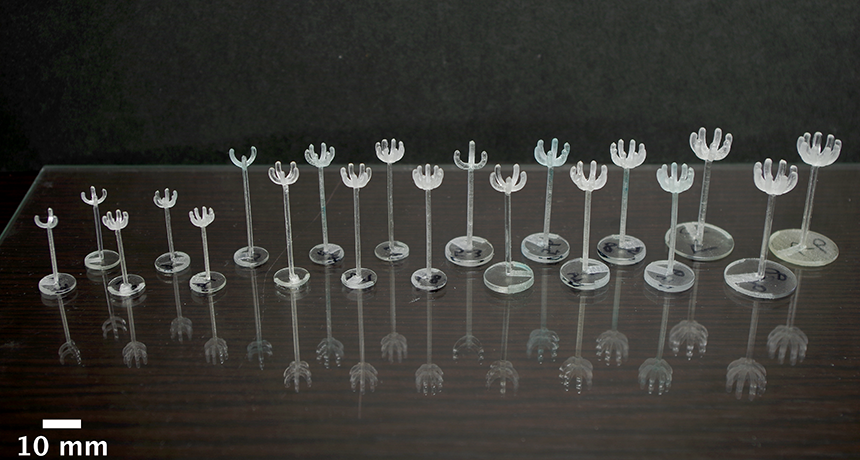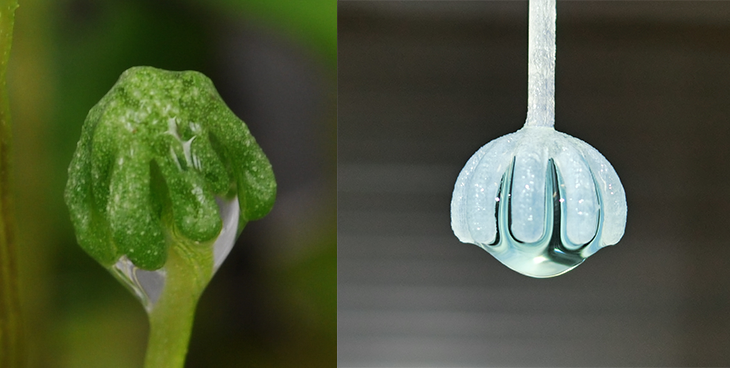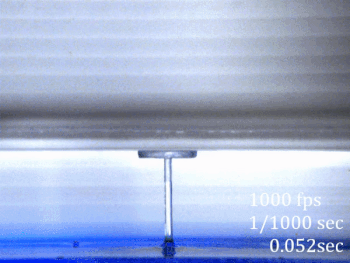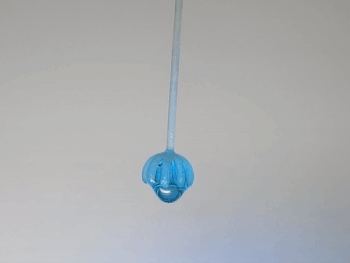An ancient plant inspires a new lab tool
This novel pipette can pick up and release tiny amounts of liquid

This is not a garden but a collection of lab tools called pipettes. They’re used to move small amounts of fluid from one place to another. And these experimental designs are based on part of a liverwort, a type of plant. (10 millimeters equals 0.4 inch.)
K. Nakamura et al/Journal of the Royal Society Interface 2018
By Sid Perkins
An ancient type of plant has inspired the creation of a new type of measuring tool. Truly tiny, it can collect and move just a few drops of liquid at most. The design, a type of pipette, has several benefits over older types. For instance, it picks up water without the need for suction.
Pipette (Py-PET) is a term from the French that means “little pipe.” As its name suggests, it’s a small tube. It works a bit like a scientific eyedropper. Chemists and other scientists use pipettes to move small, precise amounts of fluid between containers — from a beaker to a test tube, for example.
It takes a lot of practice to use a pipette accurately, notes Hirofumi Wada. He works at Ritsumeikan (RIT-su-MAY-khan) University in Kusatsu (KOO-saht-su), Japan. As a biophysicist, he studies how physical forces affect living things — or are generated by them. Wada is one of the new pipette’s designers.
Precisely controlling the suction that slurps up a small amount of liquid is challenging, he says. Pipettes may have markings on the side to help lab workers measure how much fluid they collect. But even those gauges, he notes, can be hard to read or to rely upon. So research that relies on pipetted fluids may not be as reliable as researchers would like.
Wada hopes that his team’s new device might make such problems a thing of the past.
An idea sprouts
Wada was talking with a colleague one day when they started to chat about liverworts. These are plants whose ancestors were some of the first to grow on land. Fossils suggest that would have been more than 470 million years ago. Liverworts are quite simple. They lack roots, flowers and seeds. But like many modern plants, they do come in male and female forms.
One part of the female liverwort looks like a tiny, pointy-topped umbrella. But unlike an umbrella, this part of the liverwort has no cloth covering. It has only several fingerlike projections that curve down around a stem. When rain falls on this structure, a droplet dribbles inside those “fingers.” There it becomes trapped next to the stem. This creates a moist spot for the plant’s eggs to be fertilized.
Story continues below image.

When Wada heard about this, an idea immediately sprang to mind: What if a pipette could be designed to collect and hold water the same way? His team modeled its new device, in part, on a female part of a liverwort known as Marchantia polymorpha (Mar-SHAN-tee-uh Pah-lee-MOR-fuh).
They didn’t shape the new device exactly like the plant. For one thing, the liverwort’s stem is inside the tiny cage formed by the fingers. The design team instead put the handle on the top of the pipette, like an umbrella blown inside-out by the wind. And instead of giving their pipette a pointy water-holding space, as the liverwort has, they made the space perfectly round. They thought this would make it easier to precisely control how much fluid each can hold.
But how many fingers should the pipette have? And how long should each finger be?
The researchers made different examples, or prototypes, using a 3-D printer. Some had only three fingers. Others had as many as nine, just like the liverworts that inspired them.

In some prototypes, the fingers were short. Each finger curved downward through an angle of only about 60 degrees. In other words, if the pipette stem were 12 o’clock on a watch dial, the curving fingers stopped at 2 o’clock. (The angle between those watch hands would be 60 degrees.) Other prototypes had fingers that curved downward as much as 160°. That’s slightly more than the angle between 12 o’clock and 5 o’clock on a watch. In that design, the fingerlike projections almost form a closed cage. The researchers also built pipettes in a variety of sizes.
Then they tested these devices by dipping them into different liquids. One was water. Others included olive oil and a very pure form of ethanol, a type of alcohol.
Researchers lowered the pipettes into the liquids slowly. This made sure air bubbles didn’t get trapped inside the tip. Then they gently pulled the pipette out. And if it had collected some of the fluid, they tried to move that liquid to another place and then release it.
The ideal fingers
The more fingers a pipette had, the better it held liquid. Those with nine fingers always collected a droplet, Wada reports. And the longer those fingers were, the bigger the drop a pipette could reliably hold. However, if those fingers were too long, the pipette didn’t want to release that liquid — which would be a problem for a laboratory tool.

The angle of those fingers also proved important. Those curving downward between 110° and 120° worked best. (That’s around the angle between 12 o’clock and 4 o’clock on a clock’s face.) Wada’s team described its findings March 14 in the Journal of the Royal Society Interface.
To release a droplet, the researchers only had to tilt the stem of the pipette. Gravity then pulled some of the fluid out of the side. A bit of the liquid remained behind. But the amount that flowed out was usually consistent. So it should be very easy to design a pipette to dispense droplets of a particular size, the scientists say.
The largest working pipettes had a tip about 1 centimeter (0.4 inch) across. That’s about the width of a staple, or about half the width of a penny. Such a device would hold a little more than 0.4 cubic centimeter (0.01 ounce) of liquid. (That’s equal to about one-twelfth of a teaspoon.)
How much liquid one of these pipettes can hold depends on the balance between a liquid’s surface tension and gravity, explains John Bush. He’s a mathematician at the Massachusetts Institute of Technology in Cambridge. Bush was not involved in the new study.
Gravity pulls downward on the liquid droplet. Surface tension is a measure of the attraction a liquid’s molecules have for each other. This tension helps hold the droplet together. The liverwort, Bush says, is a great example of a living organism that makes use of that balance.
Wada and his team suspect their pipettes might have uses outside the lab. Maybe robots could use them to transport liquids from one spot to another. Robots or other automated systems might have more trouble that people do in precisely controlling the suction while using a normal pipette.
And there might be more potential uses. Bush says that “you never can tell what applications one might find.” Only after people start playing with a new device, he says, do they learn where it might prove most useful.
This is one in a series presenting news on technology and innovation, made possible with generous support from the Lemelson Foundation.







